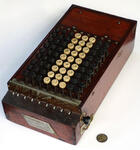
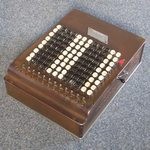
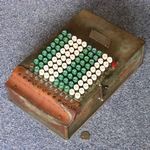
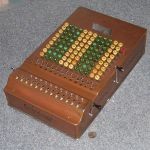
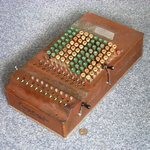
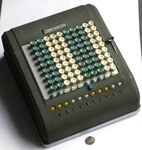
Felt & Tarrant
Comptometer models
Calculation
"Controlled-Key" mechanism
Videos
Comptometer Simulator
My wooden Comptometer
Video
My Model E Comptometer
Video
My Model J Comptometer
Super Totalizer
My Super Totalizers
Video
My Model 992 Comptometer
Video
Patents
Links
Mechanical Arithmetic, or, The History of the Counting Machine, a lecture about calculators by Dorr Felt which was published in 1916.
Books and Manuals
Tables
Comptometer Magazines
Promotional Material
Advertisements
Newspaper Articles
Paraphernalia
Dorr Eugene Felt (1862-1930) was working at a workshop when he first had the idea of what was to become the Comptometer. He was intrigued by the mechanism of a planing machine, and that gave inspiration for the mechanism of an adding machine. In 1884/5 he used a wooden macaroni box, meat skewers, rubber bands, and various other parts to build a prototype. It worked well enough to develop into a viable machine.
In 1887 he partnered with the Chicago businessman Robert Tarrant to found the Felt & Tarrant Mfg Co to manufacture and sell the Comptometer. Felt then also invented the Comptograph, an adding-listing machine that is a bit like a Comptometer with a printing mechanism. The commercial exploitation of this machine was spun off into the Comptograph Company in 1902, which was mostly handled by Tarrant while Felt dealt with the Comptometer. The Comptograph was not very successful, but the Comptometer very much was.
The Comptometer evolved through various models, but really began to take off during the first world war. As men were sent off to fight, they were being replaced by women. Felt & Tarrant had begun to set up schools where young women were trained in the use of the Comptometer, and they easily found employment in many businesses. The company also expanded internationally, and set up schools there too. It grew to be the largest private educational organisation in the world.
Dorr Felt died in 1930. He had always refused to go electric, but in 1934 the first electric comptometer was introduced, the model K, but was not as popular as the manual ones because they were less reliable and too expensive. In 1947 Felt & Tarrant became a public company, but their success continued to decline. The calculator market was very competitive, and the amount of training needed to efficiently operate a Comptometer was prohibitive. Full keyboard machines were falling out of favour compared to 10-key machines. The war also had a large impact on the international market, and after the war there were protectionist policies in Europe to help with the reconstruction. They managed to avoid these restrictions by having Comptometers made in Britain by a British company. This reduced the production in their Chicago plant, eating away their profit margins.
Felt & Tarrant tried to diversify to other office machines, in particular a dictation machine, and even went into unrelated areas by buying some companies involved in manufacturing golfing equipment. In 1957 the company was renamed the Comptometer Corporation. It was too late to halt the decline. The British manufacturing rights to the Compometer name were sold off to Bell Punch's Sumlock division in 1960. The next year the company was merged with the Victor Adding Machine Company to form the Victor Comptometer Corporation. Victor was especially interested in the Electrowriter that was in development, essentially an early fax machine. Despite it becoming part of the name of the company, the Comptometer ceased production in the US, and Victor instead sold imported Sumlock Comptometers.
The first model (with a wooden case) and the subsequent models A to E are very rare. The most common models are F, H and J. The "shoebox" case of the models A to J is made of copper plated steel that is painted brown. Any Comptometers that seem to be made of shiny copper have had their original paint stripped or polished away.
The keyboard usually consists of 8, 10 or 12 columns. Each column has 9 buttons numbered 1 to 9 from nearest to furthest. To help with touch-typing, the tops of the even-numbered keys are almost flat, while the odd-numbered keys are concave. In front of the keyboard there is a register. It is a row of small round windows through which you can see the digits of the calculation result. There is one more window/digit than there are columns of keys.
The table below lists all the Comptometer models, with their most prominent characteristics. Some models (such as B and C, or H and J) are very hard to distinguish except by serial number. The serial number limits are based on observed examples, so machines with numbers outside these ranges may exist.
There is little or no external difference between the H and J models. They use exactly the same casing, and even their serial numbers overlap during the time when the stock of H model mechanisms were used up and the production of the J model mechanisms was built up. There were apparently several internal mechanical improvements, so the ones with the improved mechanisms had their serial number preceded by the letter J. They started using green keys on the model J instead of black ones, but as keys were often replaced this is not a completely reliable characteristic.
The electrically driven model K was like an electric typewriter in that the electricity was used to generate the force needed to activate the mechanism so that the key presses could be kept very light. It had a redesigned case that raised the rear end so that the keyboard sloped at the same angle as the previous models to compensate for the fact that all keys now had the same amount of travel.
The model M also has a variant built during the war, dubbed the model WM. Due to a metal shortage its parts were redesigned to use less metal (e.g. internal plates and levers were thinner and had holes punched in them). It looks the same as the normal model M but is much lighter in weight.
For the later models I have found a table of serial numbers released by Victor, which I reproduce here:
| K | |
|---|---|
| Year | Serial No. |
| 1934 | 350000 |
| 1943 | 371000 |
| 1948 | 375757 |
| 1949 | 379747 |
| 1950 | 382734 |
| M/WM | |
|---|---|
| Year | Serial No. |
| 1939 | 400000 |
| 1942 | 430000 |
| 1946 | 462000 |
| 1948 | 489014 |
| 1949 | 505326 |
| 1950 | 514367 |
| 992/99C | |
|---|---|
| Year | Serial No. |
| 1950 | 5014 |
| 1951 | 7174 |
| 1952 | 13802 |
| 1953 | 19753 |
| 1954 | 26546 |
| 1955 | 28152 |
| 1956 | 31515 |
| 1957 | 38386 |
| 1958 | 38725 |
| 1959 | 41955 |
| 1960 | 42739 |
| 3D11 | |
|---|---|
| Year | Serial No. |
| 1950 | 6401 |
| 1951 | 8817 |
| 1952 | 19704 |
| 1953 | 27748 |
| 1954 | 32747 |
| 1955 | 35835 |
| 1956 | 37902 |
| 1957 | 42503 |
| 1958 | 44947 |
| 1959 | 46672 |
| 1960 | 48278 |
| 616CE | |
|---|---|
| Year | Serial No. |
| 1957 | 5001 |
| 1958 | 6492 |
| 1959 | 6564 |
| 1960 | 6818 |
The Comptometer is a direct adding machine. This means that when you press and release any of the numbered keys, its value is immediately added to the total shown in the register. Adding a set of numbers is therefore as simple as typing them all in. It has "duplex" functionality, meaning that it is possible to press keys from different columns at the same time to speed thing up.
The large lever on the right will clear the register, setting it to zero.
Subtraction is done by adding the tens-complement. The small digits on the keys are helpful for achieving this. To subtract a number, you must first mentally subtract 1, and then type it using the small digits. Precede the number by as many leading zeros (actually nines) as is needed to reach past the left of the current value in the register. The small metal tabs are used to block a carry, and using one here avoids the necessity of pressing any further leading zeroes in the number you are subtracting.
Multiplication is done by repeated addition. If you can press the keys for entering
one of your factors all at the same time, it is easy to press that set of keys
several times to get multiples of that number. Shift your fingers one column to the
left to add multiples of ten times your number, and so on for higher columns.
For example to multiply 6798 by 24, press 6798 down four times in the last 4
columns, shift a column to the left and press the same pattern of keys twice.
Many tricks were devised for other kinds of calculations. To increase speed and touch-typing accuracy, operators often only used the bottom half of the keyboard. Instead of entering a high digit such as 8 directly, they would press 4 twice. This reduces the need for hand movement, and is easier to do without looking.
If you press down on a key but release it before it is pressed all the way in, the mechanism of the Comptometer would not be able to register the digit you wanted. To avoid this leading to calculation mistakes, a safety mechanism was used. When a partial key press occurs, all the keys in the other columns become locked. The partial key press will not have affected the number in the register, so you can then press the intended key completely to rectify the problem. You will have to press the red button at the back right to release the locked columns to continue.
In this video I demonstrate how to do the four basic arithmetic operations on the Comptometer.
I gave a talk at the Gathering for Gardner in 2016 about the history of the Comptometer. The first video was a practice run, and the second video is the actual talk.
I have created a simulation of the Comptometer using javascript. If you click the link below, the simulation will open in a new window. If you are using a touch screen, then on most browsers you will be able to press multiple keys at the same time.
This is a wood-cased Comptometer. These were made from 1887 till 1903. It has 8 columns of keys, and a 9-digit main register. The number wheels of the register are made of metal, and visible through the openings in the metal front plate. There are carry supression tabs between the key columns, and decimal point markers between each pair of digits.
The clearing mechanism is on the right hand side, and is somewhat primitive. It consists of a clearing knob and a lever. You have to push and hold down the lever to unlock the clearing knob, and then rotate the clearing knob a full turn. You have to release the lever before you complete the turn so that the knob locks in place automatically at the end of the turn.
On the front of the case is a metal plate bearing the trademarked Comptometer name, a list of patent dates, and Felt & Tarrant Mfg. Co., Chicago. It is unusual that this plate is on the front since in all machines I have seen the plate is located on the top, just beyond the keyboard. It was probably one of the first owners who moved this plate because you can still see the holes from the screws where it used to be but there is no discolouration.
My machine has serial number 5737, and this number can be found in the middle of the metal front plate, between the decimal markers, and also on the left side of the internal mechanism. About 6300 were produced so this was one of the later ones that were made, presumably 1902 or 1903. Its keys are made of a composite, as opposed to the metal-rimmed keys that the first machines had. It is also notable that the carry mechanism can cope with simultaneous keypresses. Most wooden Comptometers do not, so the mechanism must have been improved at some point during its production run.
This Comptometer is in good condition and needed only minor repairs. I had to put all new screws on the clearing mechanism fittings, since those were missing or incorrect. I also rebuilt the clearing knob, as it had shattered into pieces during transport, and some of those pieces were missing. Below the clearing release lever there should be a pin to restrict its movement, but that is missing.
To disassemble the comptometer, you have to remove the front plate (there are screws all around its edge and two flush screws behind the decimal markers), remove the clearing knob and lever, and finally the large screws on the side of the case, two on each side. The mechanism can then be lifted out of the wooden case.
Here is a demo of the wood Comptometer.
This is a 12-column Model E Comptometer. This model was the first to include the "Controlled-Key" error detection, but also has guards on the side of the keys. If the metal guard is pressed down without first pressing the button itself, then the key will not travel further. This guards against the user accidentally catching an adjacent button during a button press. This system was dropped in subsequent models, probably because it was too complicated, the keys were prone to breaking, and because the problem it is guarding against is not common in trained operators.
My machine has serial number 56337, and was made in 1913 or 1914. This Comptometer is in fairly good condition, except that the left-most column of keys is locked. Presumably the guard system for that column is stuck. The zeroing mechanism often fails to fully reset when the handle is moved slowly. The Controlled-Key reset button is normally white in the Model E, but has been replaced here with a later red one. Some of the keys have broken during its working lifetime causing the key rod to come away from the flat stem of the guard. These keys have been patched up either by binding them together with a bit of metal wire, or by riveting them together with the key in the depressed state, effectively disabling the guard for that key. It is interesting to see that the base plate of the case for the 12-column model was built by joining together two smaller ones.
This video shows the Model E Comptometer and its key guard system in action..
This 10-column Model J Comptometer looks rather different from its original state. In the late 1940s or the 1950s it has been reconditioned, during which the casing has been wrinkle painted green, and the key-tops replaced with those from a model M or later. It has unfortunately been stored in poor conditions - the paint has discoloured and has begun to flake off.
Its internal mechanism is in fine condition, and needed only a little bit of lubrication to make it work perfectly.
This machine has serial number J314420. It has been said that the first two digits of the J number roughly match the year of production, but that is not quite accurate. The numbers range from about J245489 to J346384, which were produced from 1926 to 1938, so the machines were made about 2 to 4 years later than the first serial number digits indicate. My machine was therefore probably made in 1934.
A special version of the Model J was made, called the Super Totalizer. The mechanism and case of the model J is extended at the front to add a second register. This register has a lever on the right that causes the number shown on the normal register to be added to it, and which also then clears the normal register. The lever on the left clears the extra register.
The extra register also has a row of buttons that when pressed and locked down move a cover over the corresponding digit to hide it. Any carry operation from a covered digit to a still visible one is suppressed.
This version has the normal J serial number, but also a second serial number especially for the Super Totalizer.
Below is a list of serial numbers I compiled mostly found in online collections and auctions, and through correspondence:
| J/M number | S number | Keyboard | Source |
|---|---|---|---|
| J303108 | S483 | 12 columns | Robert M. Zollinger Jr |
| J314265 | S602 | 8 columns | Online auction |
| J315705 | S691 | 12 columns | Zsolt Árpád Papp |
| J315804 | S739 | 10 columns | Paul Breedveld |
| J316899 | S827 | 10 columns | Bart Depuydt. Keytops replaced. |
| J316912 | S843 | 10 columns | Fred Haeghens |
| J317000 | S938 | 10 columns | Online auction |
| J316821 | S1131 | 8 columns | Rechenmaschinen illustrated, H.van Noort |
| J316833 | S1151 | 8 columns | eBay, Bob Otnes |
| J317799 | S1308 | 12 columns | Jay M. Goldman |
| J317808 | S1318 | 12 columns | Computarium, François Koeller |
| J317834 | S1335 | 12 columns | Worthpoint / eBay |
| J317903 | S1415 | 12 columns | My own. |
| J321777 | S1625 | 10 columns, sterling (no farthings) | John Wolff |
| J324639 | S1854 | 10 columns | Computer History Museum |
| J324703 | S1919 | 10 columns | Robert Gotlieb |
| J324720 | S1928 | 10 columns | Rechner lexikon, Valéry Monnier |
| J324716 | S1939 | ?? columns | Arithmeum |
| J324725 | S1957 | 10 columns | Cris Vande Velde |
| J324820 | S2031 | 10 columns | Stephen Freeborn |
| J327695 | S2321 | 12 columns, sterling (no farthings) | John Wolff, not shown on his website |
| J324744 | S2563 | 10 columns | Robert M. Zollinger Jr |
| J339128 | S2594 | 8 columns | Cris Vande Velde |
| J339163 | S2620 | 8 columns | National Museum of American History |
| J342586 | S2708 | 12 columns | Online auction |
| J342835 | S2973 | 10 columns | Arithmeum |
| J342848 | S2992 | 10 columns | Bart Depuydt. In poor condition. |
| J344927 | S3077 | 8 columns | Don Feldman. In poor condition. |
| J344930 | S3080 | 8 columns | Mathematisches Maschinenmuseum |
| J345247 | S3150 | 10 columns | My own. In very poor condition. |
| M514283 | S3729 | 10 columns | Zsolt Árpád Papp |
It is not clear whether the S numbering started at 0 or at a few hundred, and it probably
did not go further than 4500 on the model J, so it is likely that between 3500 and 4500 J
Super Totalizers were produced.
In some intervals, such as between S1308 and S1415, the S numbers rise a little faster
than the J numbers. Note also that the J316821/J316833 entries on the list are out of step
with their S numbers. This probably means that at first the batches of totalizer mechanisms of various
capacities were produced separately from batches of J comptometer mechanisms, and that these
were put together according to demand.
For some reason the Super Totalizer was hardly ever shown in advertisements. Instead, the electric model K was promoted much more heavily. There was no Super Totalizer version of the model K, but later there were ST versions of the mechanical models M and 3D11. It seems that the ST models more popular in Europe and India than in the USA. It is probable that the model J Super Totalizer was assembled in the Netherlands, and is therefore more common there. Similarly, the models M ST and 3D11 ST are mostly found in Italy.
Here are some pictures of my Super Totalizer (J317903/S1415). It is in very good working condition, but has had some repairs or restoration done. In particular, 9 of the key tops have been replaced with reproductions, and the celluloid windows have been replaced with more modern plastic.
Here is a video where I demonstrate the various features of my Model J Super Totalizer Comptometer.
I have recently acquired a second ST in rather poor condition (J345247/S3150), but which can be used
for spare parts. It has 10 columns of keys, but their plastic tops have degraded, and some of them are
missing. The black and white ink of the key numbers had expanded and spread, so I have cleaned the
keys before taking these pictures. The clearing handle is badly bent, some screws are missing, as is
one of the extra register's blinds and its plastic window. The mechanism had seized up, especially
the mechanism of the extra register, but I have managed to get it mostly working again just by
spraying in some silicone lubrication. Unfortunately the clearing mechanism tends to get stuck and
I have not yet found the cause of that.
The most interesting thing about this ST is its late model number, which allows a fairly accurate
estimation for the number of model ST Comptometers produced.
This is a 10-column Model 992 Comptometer. This is an electric version of the model 3D11, both of which were produced from 1950 until at least 1957. It was advertised with the phrase Floating Touch, due to its light key action. It has the same controlled key mechanism as the 3D11, with the release button in front of the keyboard, even though that is hardly necessary with an electric machine. The electric motor is remarkably quiet.
My machine has serial number 22029. I don't know the range of serial numbers for this model so am unsure exactly when this was made, but I guess it must be around 1951-1953.
Once the upper casing is removed, the keyboard module can simply be lifted off. Each key stem is held in place by a single torsion spring, and can be removed by pushing aside the leg of the spring. The keys in a column should be removed from top to bottom so that you can push each spring by poking through the hole of the previously removed key.
This video shows the Model 992 Comptometer.
There are too many books to list here, so I have put them on a separate Comptometer Books and Manuals page.
The Felt & Tarrant company, and Dorr Felt in particular, filed a lot of patents for all aspects of their inventions and designs. Below is a list of those that relate to the shoebox Comptometer. I have omitted from this list all patents for their other office machines, as well as patents for motorized or powered versions of the Comptometer. Some of the patents listed were never used in any production models, or used only for a short time on some models prior to the model F. The most important ones are displayed in bold type.
| Patent | Filing date | Publish date | Name | Description |
|---|---|---|---|---|
| US 366,945 | 06 Jul 1886 | 19 Jul 1887 | Dorr E. Felt | Comptometer |
| US 371,496 | 12 Mar 1887 | 11 Oct 1887 | Dorr E. Felt | Improved carry mechanism |
| US 568,021 | 14 Jun 1895 | 22 Sep 1896 | Dorr E. Felt | Comptograph |
| US 661,121 | 2 May 1898 | 6 Nov 1900 | Dorr E. Felt | Comptograph improvements. |
| US 671,109 | 24 Oct 1900 | 2 Apr 1901 | Dorr E. Felt | Comptometer adapted for Sterling currency |
| US 733,379 | 3 Nov 1902 | 14 Jul 1903 | Dorr E. Felt | Case lining to reduce sound. Presumably used in Model A. |
| US 762,520 | 29 Jun 1903 | 14 Jun 1904 | Dorr E. Felt | Improved mechanism to reduce force needed. Presumably used in Model A. |
| US 762,521 | 29 Jun 1903 | 14 Jun 1904 | Dorr E. Felt | Improved register. Presumably used in Model A. |
| US 767,107 | 3 Aug 1903 | 9 Aug 1904 | Dorr E. Felt | New clearing mechanism. Presumably used in Model A. |
| US 960,528 | 16 Sep 1908 | 7 Jun 1910 | Dorr E. Felt | Improved mechanism. Adds carry-blocking buttons. Used in Model B. |
| US 982,416 | 4 Apr 1910 | 24 Jan 1911 | Dorr E. Felt | Mechanism to detect buttons pressed accidentally. Used later in Model E. |
| US 982,417 | 22 Aug 1910 | 24 Jan 1911 | Dorr Eugene Felt | Mechanism to detect buttons pressed accidentally. Used later in Model E. |
| US 992,950 | 18 Dec 1909 | 23 May 1911 | Dorr E. Felt | Mechanism to signal partial key stroke, via column indicator and bell. |
| US 996,009 | 4 Mar 1910 | 20 Jun 1911 | Dorr E. Felt | Improved carry to reduce key force needed. Presumably introduced in Model C-Light. |
| US 1,003,723 | 6 Jan 1911 | 19 Sep 1911 | Dorr E. Felt | Improved key-action (heavy to start, lighter through the down-stroke). Presumably used in the Model C-Light. |
| US 1,028,344 | 25 Nov 1911 | 4 Jun 1912 | Dorr E. Felt | Controlled-key mechanism, locking other keys after partial key stroke. |
| US 1,066,096 | 12 Jul 1912 | 1 Jul 1913 | Dorr E. Felt | Improved controlled-key mechanism, not releasing partially pressed key until fully pressed. |
| US 1,072,933 | 5 Apr 1913 | 9 Sep 1913 | Dorr E. Felt | Complete controlled-key mechanism. |
| US 1,072,934 | 5 Apr 1913 | 9 Sep 1913 | Dorr E. Felt | Improved clearing mechanism, reduced jamming with improper use. |
| US 1,074,689 | 30 Sep 1912 | 7 Oct 1913 | George Steninger Bollensen | Keyboard with a fractions column |
| US 1,074,704 | 5 Apr 1913 | 7 Oct 1913 | Dorr E. Felt | Keyboard with several columns for common fractions |
| US 1,074,705 | 5 Apr 1913 | 7 Oct 1913 | Dorr E. Felt | More reliable clearing mechanism |
| US 1,110,734 | 3 Mar 1914 | 15 Sep 1914 | Kurt F. Ziehm | New Controlled-Key mechanism. Presumably introduced in the Model F. |
| US 1,154,897 | 9 Oct 1911 | 28 Sep 1915 | Joseph Abram Turck | Improved mechanism to reduce key force needed. |
| US 1,357,747 | 1 May 1918 | 2 Nov 1920 | Joseph A. V. Turck | New clearing mechanism. Introduced in Model H. |
| US 1,357,748 | 1 Dec 1919 | 2 Nov 1920 | Joseph A. V. Turck | Improvement on the new clearing mechanism, with bell. Introduced in Model H. |
| US 1,391,220 | 24 Apr 1920 | 20 Sep 1921 | Joseph A. V. Turck | Early version of the Super Totalizer. |
| US 1,449,639 | 19 May 1921 | 27 May 1923 | Joseph A. V. Turck | Controlled-key mechanism that also locks clearing lever. |
| US 1,714,964 | 12 Mar 1921 | 28 May 1929 | Joseph A. V. Turck | Column indicator for controlled-key mechanism. |
| US 1,751,609 | 8 Oct 1923 | 25 Mar 1930 | Joseph A. V. Turck | Block clearing handle when controlled-key mechanism active. |
| US 1,817,640 | 30 Apr 1929 | 04 Aug 1931 | Neal Eberhart Newman; Frederick Adolph Niemann | Peg-Board system. |
| US 1,840,378 | 27 Oct 1926 | 12 Jan 1932 | Carlos Wittenmyer | Carry blocking levers that are automatically released by carry. |
| US 1,902,597 | 29 Sep 1927 | 21 Mar 1933 | Joseph A. V. Turck | More reliable clearing mechanism. Presumably introduced in Model J. |
| US 1,927,856 | 29 Sep 1927 | 26 Sep 1933 | Joseph A. V. Turck | Operator-controlled locking of key columns and digits. |
| US 2,104,051 | 16 May 1935 | 4 Jan 1938 | Frederick A. Niemann | Super Totalizer digit blinds. |
| US 2,130,364 | 5 Nov 1934 | 20 Sep 1938 | Frederick A. Niemann | Super Totalizer. |
| US 2,149,817 | 5 Nov 1934 | 7 Mar 1939 | Frederick A. Niemann | Super Totalizer. |
| USD 113,817 | 26 Aug 1938 | 14 Mar 1939 | Frederick A. Niemann, Alfred L. Mell | Model M case design. |
| US 2,273,491 | 28 Apr 1939 | 17 Feb 1942 | Haldon A. Leedy | Vibration proofing mounting of mechanism and case |
| US 2,346,601 | 24 Feb 1941 | 11 Apr 1944 | Frederick A. Niemann | Hide leading zeroes |
| US 2,753,117 | 22 Sep 1954 | 3 Jun 1956 | Emil C. Walker | Customatic mechanism |
© Copyright 2015-2025 Jaap Scherphuis, mechcalc a t jaapsch d o t net.